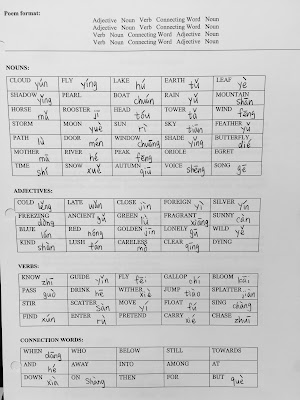It doesn’t matter when do you want to do this, but finally, you would love your students to write their own poems in Chinese. It may sounds a little bit crazy at this point, since your students probably can not even make complete sentences in Chinese. Don’t worry, my students do not really know how to make complete sentences at this time either, however, you may be impressed by some of their poems! Remember, the most important thing for them is not to speak perfect Chinese, but to experience, and enjoy learning Chinese. Here I’ll let you know how I did it.
I really appreciate the teacher’s guide for A Thousand Peaks: Poems from China, a picture book introduces and collects Chinese poems and includes their translations, written by Siyu Liu and Orel Protopopescu. I don’t have the book, but I got the teacher’s guide online and I feel it is really helpful. From a teacher’s point of view, it gives the idea on how to teach poem as well as teach the language. The guide starts with an introduction on Chinese poem’s history, structure and wording etc., and followed by a series of instructions on how to guide students writing their own poems. As suggested in the guide, the way to scaffold students is providing the pattern of a poem as shown in the following chart:
Adjective Noun Verb Connecting Word Noun
Adjective Noun Verb Connecting Word Noun
Verb Noun Connecting Word Adjective Noun
Verb Noun Connecting Word Adjective Noun
One type of Chinese poem is composed of four sentences, and five characters in each line. In order to make it easier, the pattern has fixed properties for each character. On the next page of the guide, the authors provide four lists of English words that fall into each of the categories. I didn’t really read through the instruction on how to do this activity from the guide, while just by looking at these two charts, I fostered the idea in my head to let my students pick up words from the lists and compose their own poems. While just finishing the poem in English with a Chinese pattern is obviously not enough. Since we just introduced the origin of Chinese characters from our previous lessons, I wish the students could design their own characters according to their imaginations. So in the end, what I expected from the students were “looking like but not really” Chinese poems.
I talked about this idea with one of my colleagues, or my mentor, and I indicated that my concern was if this activity was too difficult for my students, and what if they told me that they had no idea how to design their own characters. I know my students well, that no matter how interesting I think one activity is, there must be some of them think it is boring and too hard for them to finish. The suggestion from my mentor really inspired me a lot and made me feel confident that this activity would work well. He told me that I could bring my students outside and let them feel the nature while they were writing the poems. I think it was a great idea since students could look around and get inspiration from the nature about how they want to design their characters, since anyway, it was how the ancient people created the characters in a real case from thousands of years ago.
Here are the steps that you can follow to adopt this activity:
- Bring your students to the outside, and ask them to look around and relax;
- Follow the pattern, ask your students to pick up words from the lists to finish their poems
- Ask students to design characters for each word, and put them onto the “rice” paper (image 1) as their final work (they need to write from right to left, and top to bottom, like ancient people!)
- Share their poems in the class
 |
| image 1 |
 |
| image 2 |
By providing the lists of words, I put Chinese translations (Pinyin) on the side (image 2). However, for some of the words I left them blank since there are more than one translation in Chinese for that specific words, and it depends on the context of the whole poem to select the best one. For example the word “dying” from the category of “Verbs” could be translated into “逝 (shi)” or “灭 (mie)” in Chinese depending on different situations. Therefore, I asked my students to come to me whenever they chose words like those. Also, I asked my students to put their final works in an ancient way (writing vertically). I always remind me that the most important thing for students who are learning a foreign language in this age are more like experiencing new things and having fun than studying something seriously! So this is one part of it! And if you also like it, try it!
 |
| Student Work |
Teaching Tips 教学小贴士:
- Some of the word might be too abstract for students to design a character for, so you may want to show them how we write it nowadays to give them a hint.
- Some of my students said they didn’t want to design their own characters and just want to copy the real Chinese characters instead. You may talk about this in advance, to set your expectation and how do you want to deal the case like this.


